-

人教版高中英语必修5First aid说课稿6篇
In this class, I have 3 teaching aims, that is, knowledge aims, ability aims and emotion aims.1) Knowledge-Teach students new words and expressions, such as temporary, bleed,sprain choke, first aid, fall ill and so on.-Enable students to have a better understanding for some basic knowledge of first aid.2) Ability-Train students’ speaking, reading and writing abilities by different teaching activities, such as skimming, comprehending, team work, role play, retelling and writing.-Develop students’ reading strategy on how to move general idea to specific information.3) Emotion-Promote students’ awareness of giving first aid.- Cultivate students’ creativities.Then let’s come to my teaching methods and activities.III. Teaching methods and activities:To achieve different teaching aims, various kinds of teaching methods and activities will be adopted throughout this period, such as TBL (task-based learning), skimming, team work, brainstorm and others, which can offer students opportunities to fulfill tasks in which they can use language to achieve a specific outcome.IV. Teaching aids:Computer and blackboardV. Teaching important points:1) Make students have a clear mind for the structure of the text.2) Help students understand the theme of the text.VI. Teaching difficulties:1) So many new words may affect students’ understanding.2) How to get students to know about the functions of the skin and thecauses, characteristics and treatments for different degree burns,and the knowledge about giving first aid. VII. Blackboard design:

人教版高中英语必修5Great scientists说课稿4篇
通过写文章梗概,培养学生综合运用语言的能力,学习用恰当的英语描述科学家的故事。这是本课的教学难点。教师可以使用完形填空的方式来帮助学生整理语篇,从而来降低难度。本课的教学重点的突破方法是:在阅读前,让学生初步了解得出科学观点所需要的基本程序,从而轻松而自然地导入文章的阅读;在阅读过程中,由易到难设计快速阅读和精读的问题,层层推进各种阅读活动,让学生对阅读内容从整体感知到细节理解,最后深层读懂整篇文章,同时加强阅读策略的指导,让每个学生都主动参与课堂教学活动,最终达到提高阅读能力的目的。Step 4 Post-readingGroup Activities四人小组共同合作,在老师的适当指导下,就以下2个问题展开讨论,让学生就所知、所学、所感和所想融入话题,然后抽若干同学代表作小组发言。1. What do you think about John Snow, and what should we learn from him?2. Cholera was 19th century disease, which two diseases are similar to cholera today? Why?

人教版高中英语必修5Life in the Future说课稿5篇
Good afternoon, everyone. It’s my great pleasure to be here sharing my lesson with you. The content of my lesson is Senior English for China Book5 Unit 3 Life in the Future. I’ll be ready to begin this lesson from six parts: Analysis of the teaching material, Analysis of the students, Teaching aims and important and difficult points, Teaching methods and aids, Teaching procedures, and Blackboard design. First, let me talk about the teaching material.Part 1 Analysis of the Teaching Material:This unit is about what human beings’ life will be like in about one thousand years. By studying of this unit, we’ll Enable the students to know the changes in humans’ life and some new inventions bringing about the change and develop the interest in science. This lesson plays an important part in the English teaching in this unit. This is an important lesson in Book Five. From this lesson, it starts asking the Ss to grasp contents of each passage. Therefore, this lesson is in the important position of the teaching material. If the Ss can learn it well, it will be helpful to make the Ss learn the rest of this unit.Part 2 Analysis of the SsAs Senior2 Ss, they are at different levels of English fluency, some of them have lost interest in English. So during the lesson, I arrange a variety of activities to let all of them join in to attract their interest and let them be confident and taste the joy of success.

人教版高中英语必修5Making the news说课稿4篇
今天我们来介绍一下必修五第四单元的授课方式。这个单元的题目是Making the news。应该是学生比较感兴趣的话题,学生往往对新闻工作充满好奇,所以我们可以利用这个机会多设计一些师生互动和学生互动,来激发起学习的积极性,提高学习效率。同时我们可以利用这个单元不仅帮助学生掌握语言知识,培养语言能力,同时让其了解新闻工作的重要性,培养起社会智能感。这个单元分为六个课时,它的教学目标是这样的:语言目标是掌握词汇表中的常用单词和短语,掌握倒装句的一些基本用法。 技能目标是能初步掌握约会的基本句型并在真实的场景下正确运用。新闻报道类文章的写作技能。采访的基本规范和沟通技能。情感目标是对新闻报道的客观性和真实性有更好的理解。对新闻记者的职业有更深入的了解,并能体会其工作的重要性。下面我们来介绍一下第一课时的授课方式,第一课的教学目标是这样的第一课时的教学目标语言目标:单词:Occupation, journalist, editor, photographer, curious, personality, enthusiasm

人教版高中英语必修4A taste of English Humor说课稿3篇
Then I would ask them to think of a funny English or Chinese and tell it to partners. While telling stories, they can use expressions and some acting to help make the story funny. 5 minutes would be given to do this.Those stories they told there will be the material for their writing. Soletting them tell it at first is helpful. And they can make a difference between telling a funny story and writing it down. Generally speaking, it is difficult forstudents to write well because they don’t know what to write and how to write. Asking them to tell their own stories at first can help them come up with what to write.After their telling, I would invite someone to share his/her story with all of us and I would write it down on the blackboard.This example story would be used as a sample to illustrate the format of funny story. Different from a story from teacher or textbook, a story from students can obviously become a interesting material to draw students’ attention.Then I would ask the whole class to put this story into several parts. It might be a little bit difficult for them. So I would ask them to find out whether all the sentences are necessary. After delete some sentences, there are 6 sentences left behind. Then they can easily put them into three parts. After interaction with students, I would teach them the right terms for each part and conclude the format of funny story.This step is the key and difficult point in my lesson. So I mainly usetask-based teaching method in this part and the task for students was divided into several stages. With the separated difficult level, students can find there are usually three parts in writing. They can also learn to write without the unnecessary parts in the process of analyzing. And then I wouldn’t rush to tell them the right terms to them directly. Instead, I would ask them to name them by their own. A confused mind is better for acquiring knowledge.While-writing:Then I would give students 7 minutes to write down this story, without other requirements.With all the preparations in pre-writing, students’ difficulties were cleared. So it would be much easier for them to write down the story within 7 minutes. There are no other requirements because students’ first writing is actually a drafting. It would be revise and edit several times later. Writing, as a skill

人教版高中英语必修3Healthy Eating说课稿4篇
Language learning needs a context, which can help the learners to understand the language and then can product comprehensible output, so computer has the advantages to make the materials attractive.Part 3 Learning MethodsTask-based, self-dependent and cooperative learningPart 4 Teaching ProcedureStep One Lead-in“Interest is the best teacher.” Therefore, at the very beginning of the class, I should spark the students’ mind to focus on the centre topic “the band”. I’ll show some pictures of food to attract their attention and then bring some questions.Question:What kind of food they like?What should go into a good meal?The answers must relate to the diet. After this, the students will be eager to know something about a balance diet and this is the very time to naturally lead the class into Step 2Step 2 Reading for information: skimming and scanning In this step, I use Task-based Language Teaching method, which can give students a clear and specific purpose while skimming and scanning the context.Task 1 General ideaThe students will be asked to just glance at the title and the pictures of the passage, and then guess what they will read in the text. And they’ll be divided into groups of four to have a discussion.The purpose is to inspire the students to read actively, not passively. In addition, the task is to develop the students’ reading skill by making prediction and to encourage the students to express their thoughts in English and cooperate with each other.Task 2 Main idea of each paragraphCooperative learning can raise the students’ interest and create an atmosphere of achievement. Based on this theory, I divide the whole class into 4 groups to skim the whole text and get the main idea of each paragraph.

人教版高中英语必修3The million pound bank note说课稿3篇
在接下来的细读环节,我套用了高考对阅读理解的考查方式设置了5个问题,分别为三个推理判断题,一个细节题和一个主旨大意题。学生需要对文章的内容进行分析、归纳、推理、猜测等高级思维活动才能做出正确的回答。【设计意图】这一过程是对学生进行细读的训练,培养学生获取特定信息和挖掘文章深层次信息的能力。第三环节:Intensive-reading (精读) 15′第三个环节精读,既是最重要的环节,也是突破本课重难点的关键。首先,让学生思考剧本中人物看到百万英镑前后的态度发生了怎样的变化。其次,让学生仔细阅读文章,找出可以表现人物态度变化的具体的语言和动作。最后,让学生总结人物的态度发生变化的根本原因是什么,从而引出Money Talks, 供学生思考。【设计意图】通过一系列的活动培养学生学习从人物的语言和动作探究人物的心理,使学生进一步体会戏剧语言的魅力,从而对文章背后所反映的社会问题进行思考,也为下一步的讨论环节做好铺垫。

人教版高中英语必修5The United Kingdom说课稿4篇
Teaching Aims:Knowledge 1. Get the students to learn the useful new words and expressions in this section. Aims:2. Let the students learn about how the UK was formed and the four groups of invaders.1. Develop students’ reading ability and let them learn different Ability reading skills. Aims:2. Enable students to learn to talk about the United Kingdom and the Union Jack Emotional 1. Let students know more about the UK2. Develop students’ sense of cooperative learning Aims:Teaching Important Points:1. Let the students learn about the countries of the United Kingdom and the Union Jack2. Get the students to read the passage and know about how the UK was formed and the four groups of invaders.3. Have the students learn different reading skills.Teaching Difficult Ponts:1. Develop students’ reading ability.2. Enable students to talk about the United Kingdom and the Union Jack.3. Let students learn how the UK was formed geographically and historically.Teaching Methods:Showing pictures, asking, exercising, listening, reading etc.Teaching Aids:A computer,a projector and a blackboard.Teaching Procedures: 1) Show a map of the world, ask students the following questions:Where is the UK?What’s the full name of the UK?2) Ask the students work in pairs to do the quiz on Page 9.Do you want to test how many things you know about the United Kingdom? Let’s have a small test.Using the map on P9, students answer the following questions:?How many countries does the UK consist of? What are they??England is divided into three main areas. Do you know what they are? 1) Scanning (10Minutes )Let the students hold the questions asked in pre-reading and read the passagequickly and then let them do the following exercise.Join lines to the right answer.
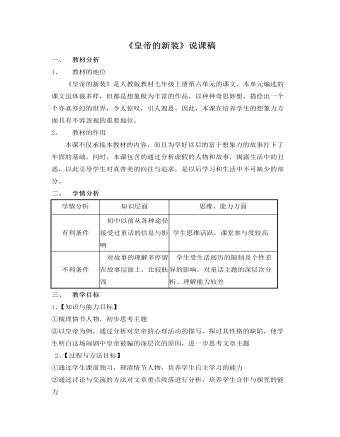
部编版语文七年级上册《皇帝的新装》说课稿
三、 教学目标1、【知识与能力目标】①梳理情节人物,初步思考主题②以皇帝为例,通过分析对皇帝的心理活动的描写,探讨其性格的缺陷,使学生明白这场闹剧中皇帝被骗的深层次的原因,进一步思考文章主题2、【过程与方法目标】①通过学生课前预习,理清情节人物,培养学生自主学习的能力②通过讨论与交流的方法对文章重点段落进行分析,培养学生合作与探究的能力3、【情感态度与价值观】对皇帝的性格缺陷的探讨、分析,引导学生以此为镜子,正确的认识自己,自我鞭策四、 教学重、难点【重点】梳理情节人物,初步思考主题【依据】立足课程标准,结合教材、学情和教学目标的分析【难点】通过对分析皇帝心理活动的描写,探讨其性格上的缺陷,使学生理解皇帝被骗的深层次原因,进一步思考文章主题【依据】立足课程标准,结合教材分析、本课的指导思想
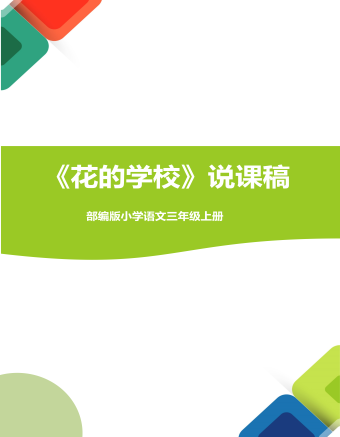
《花的学校》说课稿
教学目标:1.知识目标:会写本课生字,正确认读生字。正确、流利、有感情地朗读课文,默读课文,能对课文中不理解的地方提出疑问。2.能力目标:理解课文内容,体会课文富于童真童趣的语言和丰富细腻的想像,培养学生的质疑、表达、想象能力
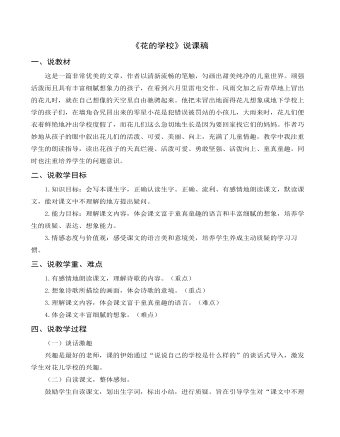
《花的学校》说课稿
鼓励学生自读课文,划出生字词,标出小结,进行质疑。旨在引导学生对“课文中不理解的地方提出疑问”,引导学生抓住要点、抓住关键提出有价值的问题,这种质疑能力对学生的阅读水平的提高具有重要的作用。
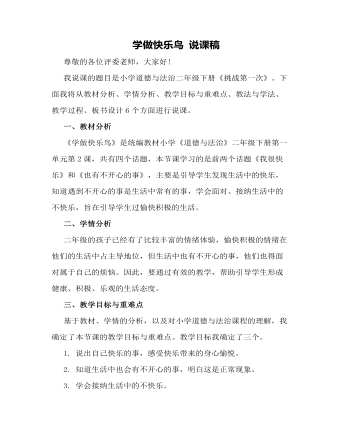
学做快乐鸟 说课稿
尊敬的各位评委老师,大家好!我说课的题目是小学道德与法治二年级下册《挑战第一次》。下面我将从教材分析、学情分析、教学目标与重难点、教法与学法、教学过程、板书设计6个方面进行说课。一、教材分析《学做快乐鸟》是统编教材小学《道德与法治》二年级下册第一单元第2课,共有四个话题,本节课学习的是前两个话题《我很快乐》和《也有不开心的事》,主要是引导学生发现生活中的快乐,知道遇到不开心的事是生活中常有的事,学会面对、接纳生活中的不快乐,旨在引导学生过愉快积极的生活。二、学情分析二年级的孩子已经有了比较丰富的情绪体验,愉快积极的情绪在他们的生活中占主导地位,但生活中也有不开心的事,他们也得面对属于自己的烦恼。因此,要通过有效的教学,帮助引导学生形成健康、积极、乐观的生活态度。三、教学目标与重难点基于教材、学情的分析,以及对小学道德与法治课程的理解,我确定了本节课的教学目标与重难点。教学目标我确定了三个。1. 说出自己快乐的事,感受快乐带来的身心愉悦。2. 知道生活中也会有不开心的事,明白这是正常现象。3. 学会接纳生活中的不快乐。教学重点是:引导学生发现生活中的快乐,知道遇到不开心的事也是正常现象。
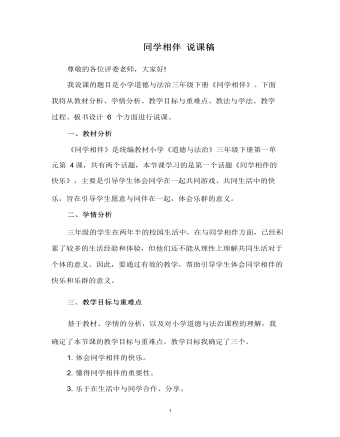
同学相伴 说课稿
尊敬的各位评委老师,大家好!我说课的题目是小学道德与法治三年级下册《同学相伴》。下面 我将从教材分析、学情分析、教学目标与重难点、教法与学法、教学 过程、板书设计 6 个方面进行说课。一、教材分析《同学相伴》是统编教材小学《道德与法治》三年级下册第一单 元第 4 课,共有两个话题,本节课学习的是第一个话题《同学相伴的 快乐》,主要是引导学生体会同学在一起共同游戏、共同生活中的快乐,旨在引导学生愿意与同伴在一起,体会乐群的意义。 二、学情分析三年级的学生在两年半的校园生活中,在与同学相伴方面,已经积累了较多的生活经验和体验,但他们还不能从理性上理解共同生活对于个体的意义。因此,要通过有效的教学,帮助引导学生体会同学相伴的快乐和乐群的意义。三、教学目标与重难点 基于教材、学情的分析,以及对小学道德与法治课程的理解,我确定了本节课的教学目标与重难点。教学目标我确定了三个。1. 体会同学相伴的快乐。2. 懂得同学相伴的重要性。3. 乐于在生活中与同学合作、分享。教学重点是:体会同学相伴的快乐和乐群的意义。难点是:体会共同生活对于个体的意义。
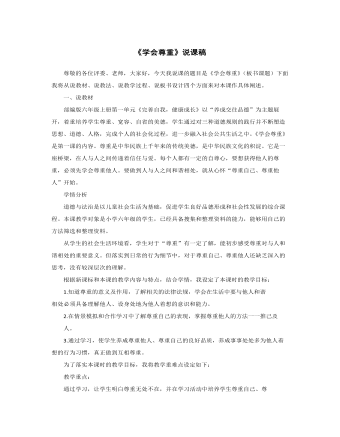
学会尊重 说课稿
尊敬的各位评委、老师,大家好,今天我说课的题目是《学会尊重》(板书课题)下面我将从说教材、说教法、说教学过程、说板书设计四个方面来对本课作具体阐述。一、说教材部编版六年级上册第一单元《完善自我,健康成长》以“养成交往品德”为主题展开,着重培养学生尊重、宽容、自省的美德,学生通过对三种道德规则的践行并不断塑造思想、道德、人格,完成个人的社会化过程,进一步融入社会公共生活之中。《学会尊重》是第一课的内容。尊重是中华民族上千年来的传统美德,是中华民族文化的积淀。它是一座桥梁,在人与人之间传递着信任与爱。每个人都有一定的自尊心,要想获得他人的尊重,必须先学会尊重他人。要做到人与人之间和谐相处,就从心怀“尊重自己、尊重他人”开始。学情分析道德与法治是以儿童社会生活为基础,促进学生良好品德形成和社会性发展的综合课程。本课教学对象是小学六年级的学生,已经具备搜集和整理资料的能力,能够用自己的方法筛选和整理资料。从学生的社会生活环境看,学生对于“尊重”有一定了解,能初步感受尊重对与人和谐相处的重要意义。但落实到日常的行为细节中,对于尊重自己、尊重他人还缺乏深入的思考,没有较深层次的理解。
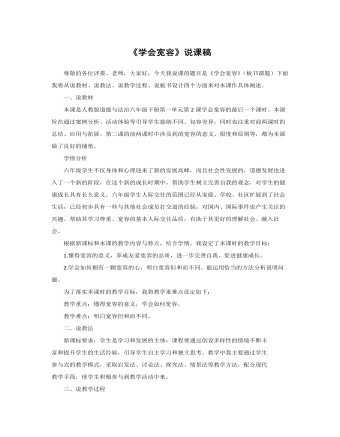
学会宽容 说课稿
说教材本课是人教版道德与法治六年级下册第一单元第2课学会宽容的最后一个课时。本课旨在通过案例分析、活动体验等引导学生接纳不同、包容差异,同时也注重对前两课时的总结、应用与拓展。第二课的前两课时中涉及到的宽容的意义、限度和原则等,都为本课做了良好的铺垫。学情分析六年级学生不仅身体和心理迎来了新的发展高峰,而且社会性发展的,道德发展也进入了一个新的阶段,在这个新的成长时期中,帮助学生树立完善自我的观念,对学生的健康成长具有长久意义。六年级学生人际交往的范围已经从家庭、学校、社区扩展到了社会生活,已经初步具有一些与其他社会成员打交道的经验,对国内、国际事件也产生关注的兴趣。帮助其学习尊重、宽容的基本人际交往品质,有助于其更好的理解社会、融入社会。根据新课标和本课的教学内容与特点,结合学情,我设定了本课时的教学目标:1.懂得宽容的意义,养成友爱宽容的品质,进一步完善自我,促进健康成长。2.学会如何拥有一颗宽容的心,明白宽容但和而不同。能运用恰当的方法分析说明问题。为了落实本课时的教学目标,我将教学重难点设定如下:教学重点:懂得宽容的意义,学会如何宽容。教学难点:明白宽容但和而不同。
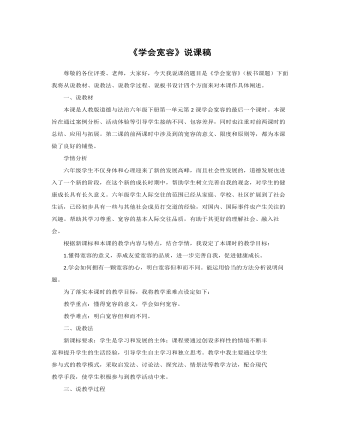
学会反思 说课稿
尊敬的各位评委、老师,大家好,今天我说课的题目是《学会反思》(板书课题 )下面我将从说教材、说教法、说教学过程、说板书设计四个方面来对本课作具体阐述。1、说教材本课是第一单元“完善自我 健康成长"的第3课,本课是在前 五年我的健康成长主题学习的基础上,聚焦反思。本课包括“生活离 不开反思"和“养成反思好习惯"两部分内容。教学时应从学生己有 知识经验出发,运用生动活泼例子、故事,让学生参加活动,在实践 中明白反思的重要性,从而学会反思的方法。学情分析本班多数学生养成良好的学习和生活习惯,对道德与法治这一学科很感兴趣。由于本班留守儿童较多,缺乏家庭教育,导致了少部分的学困生,这就要求教师加强对学困生的教育和引导,让他们尽快养成良好的学习习惯。根据新课标和本课的教学内容与特点,结合学情,我设定了本课时的教学目标:1.懂得反思的意义,养成反思的行为习惯,进一步完善自我,促进健康成长。2.学习从不同的角度反思自己。3.初步掌握收集、整理和运用信息的能力。为了落实本课时的教学目标,我将教学重难点设定如下:教学重点:懂得反思的意义,养成反思的行为习惯。教学难点:学习从不同的角度反思自己。
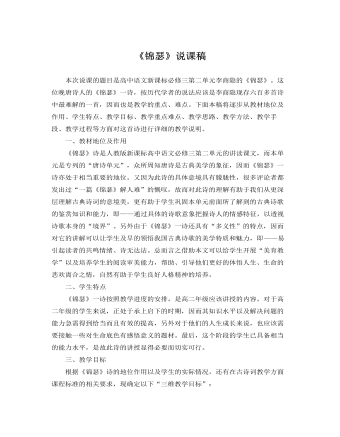
人教版高中语文必修3《锦瑟》说课稿
三、教学目标根据《锦瑟》诗的地位作用以及学生的实际情况,还有在古诗词教学方面课程标准的相关要求,现确定以下“三维教学目标”:(一)知识与技能目标:感受体悟古典诗歌的意境美,发挥合理的主观能动性进行创新性的阅读鉴赏,正确认识意象在诗歌意境中的重要作用。并在上述的基础上提高鉴赏能力和审美情操。(二)过程与方法目标:《锦瑟》诗的讲解采用“引导与自我生成”的方法,从老师的引导开始,以学生的研讨交流再加之教师的总结结束。利用教师引导和师生互动刺激学生的领悟力,提高学生的认知水平与能力。(三)情感态度价值观目标:培养学生在尊重传统文化的基础上热爱祖国自己文化的态度,让学生正确认识古典诗词的精神美。最后在自我感悟中陶冶情操,明心启智。
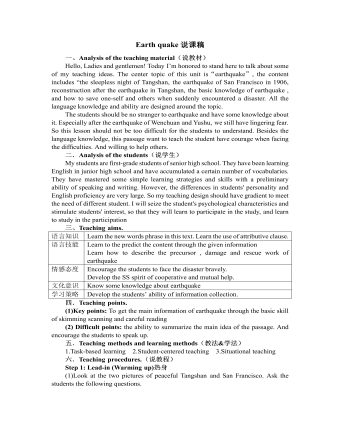
人教版高中英语必修1Earth quake说课稿
(4)Finally, I will ask the SS what this sentence mean:It is always calm before a storm.Purpose: attract the SS attention and bring them into discussionStep 2: Pre-reading 读前Here, I will do the second question in pre-reading first. I will use the method of brainstorming to ask the SS what will happen before an earthquake; and list the phenomenon on the table. 2. Then I will show the SS the picture of abnormal phenomenon, at the same time, encourage the SS to describe.3、finally, I will summarize these phenomenon4、Do the first question in the pre-reading , Imaging your home begins to shake and you must leave it right away. You have time to take only one thing. What will you take? Why?Purpose: help the SS to get further understanding of the topic and stimulate their interests.Step3: While-reading 阅读(1). Skimming Read the text quickly and catch the meaning of the first and second sentence of each paragraph. Predict the meaning of new words(2).scanning(找读)A. Read the text again. Do the following question.1. When and where were the strange things happening?2. What are they?3. Why did the text say the world seemed to be at an end?4. How was the city destroyed after the quake?5. When did the second quake hit the city? What was the result of that?6. Who came to help Tangshan first? And how?B. Work in pairs to discuss the question.
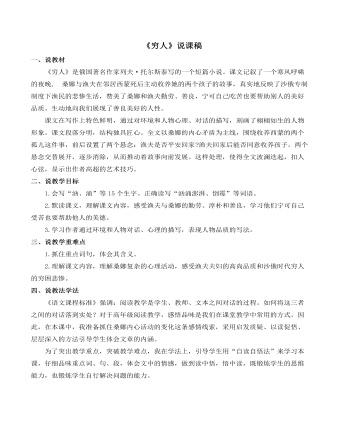
《穷人》说课稿
1.会写“汹、涌”等15个生字。正确读写“汹涌澎湃、倒霉”等词语。? 2.默读课文,理解课文内容,感受渔夫与桑娜的勤劳、淳朴和善良,学习他们宁可自己受苦也要帮助他人的美德。?3.学习作者通过环境和人物对话、心理的描写,表现人物品质的写法。?三、说教学重难点1.抓住重点词句,体会其含义。2.理解课文内容,理解桑娜复杂的心理活动,感受渔夫夫妇的高尚品质和沙俄时代穷人的穷困悲惨。?四、说教法学法? 《语文课程标准》强调:阅读教学是学生、教师、文本之间对话的过程。如何将这三者之间的对话落到实处?对于高年级阅读教学,感悟品味是我们在课堂教学中常用的方式。因此,在本课中,我准备抓住桑娜内心活动的变化这条感情线索,采用启发质疑、以读促悟、层层深入的方法引导学生体会文章的内涵。?为了突出教学重点,突破教学难点,我在学法上,引导学生用“自读自悟法”来学习本课,仔细品味重点词、句、段,体会文中的情感,做到读中悟,悟中读,既锻炼学生的思维能力,也锻炼学生自行解决问题的能力。
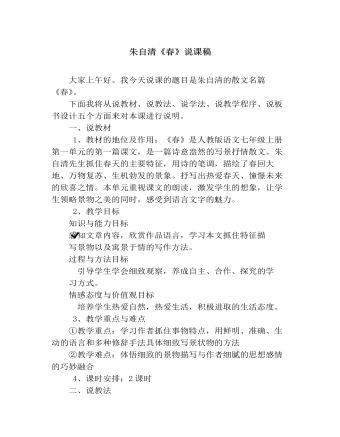
部编版语文七年级上册《春》说课稿
一、说教材1、教材的地位及作用:《春》是人教版语文七年级上册第一单元的第一篇课文,是一篇诗意盎然的写景抒情散文。朱自清先生抓住春天的主要特征,用诗的笔调,描绘了春回大地、万物复苏、生机勃发的景象。抒写出热爱春天、憧憬未来的欣喜之情。本单元重视课文的朗读,激发学生的想象,让学生领略景物之美的同时,感受到语言文字的魅力。2、教学目标知识与能力目标 感知文章内容,欣赏作品语言,学习本文抓住特征描写景物以及寓景于情的写作方法。过程与方法目标引导学生学会细致观察,养成自主、合作、探究的学习方式。情感态度与价值观目标培养学生热爱自然,热爱生活,积极进取的生活态度。3、教学重点与难点 ①教学重点:学习作者抓住事物特点,用鲜明、准确、生动的语言和多种修辞手法具体细致写景状物的方法②教学难点:体悟细致的景物描写与作者细腻的思想感情的巧妙融合

